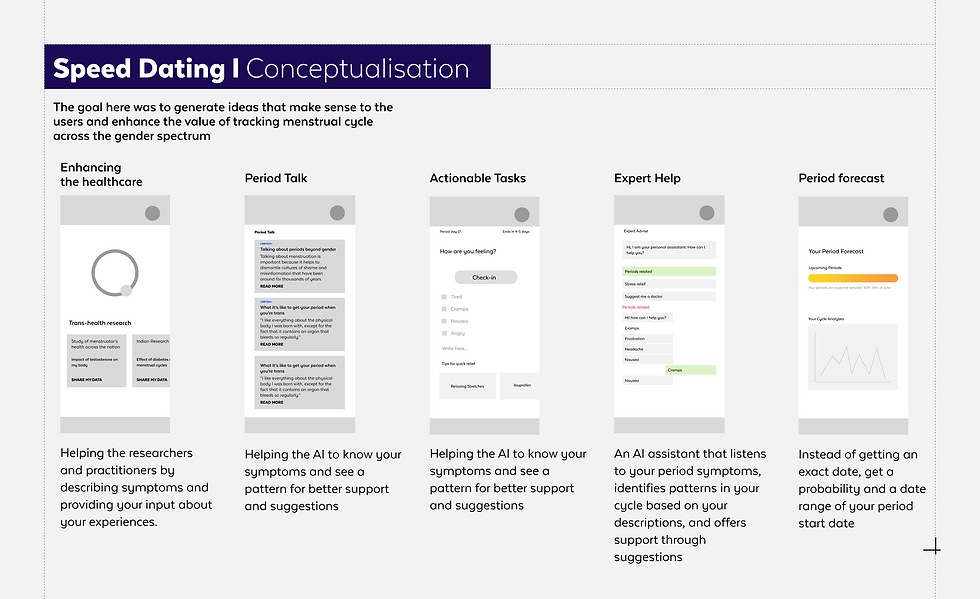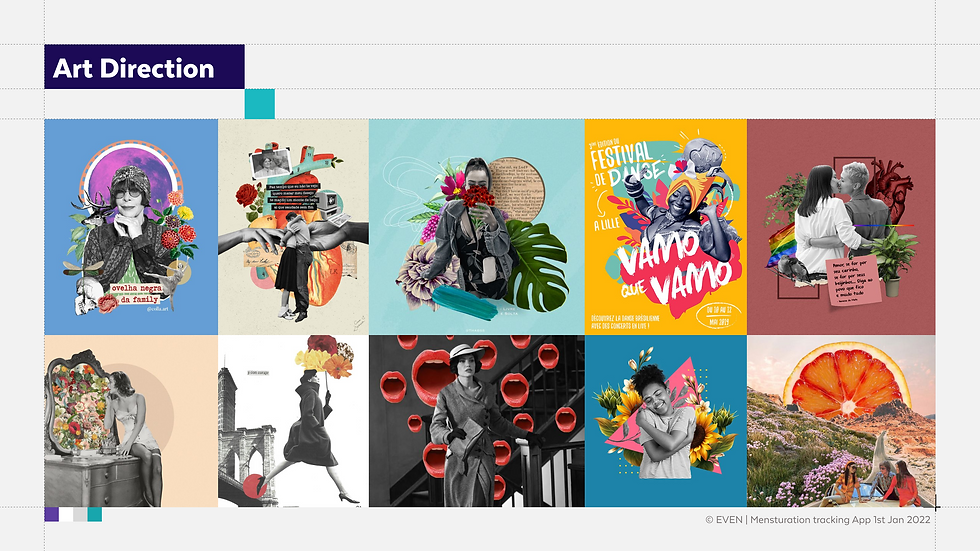About the Project
The menstrual cycle is a key health indicator for menstruators who comprise roughly 50% of the world’s population. Historically, menstruation has been considered taboo; talking about it is considered shameful and embarrassing. The shame and embarrassment emerge from the complex social constructs and stigmas associated with menstruators’ bodies across cultures and societies of the world. In India, it has reached another level, and in many of the households, even “so-called” educated people stop menstrutors enter into temples and the kitchen.
The researchers indicate that, following inabilities that are needed to be addressed:
Wrongly assuming sexual identity of users
Bias towards fertility
Emphasis on pink, flowery and feminine form
over customization options
Inability to support diverse needs of users
Exclusion of men
The advent of technology has made health tracking for self-awareness a commonplace. One of the so-called “sufficiently well-studied’’ health tracking activities is the tracking of periods. Many digital applications exist to track the menstrual cycle. However, most of these applications fail their users in many ways, like wrong assumptions about the gender identity and sexual orientation of users, a biased focus on fertility, and an inability to support the diverse needs of the users.
My other major concern is that men have always been excluded from menstruation in Indian society, while in reality, they should be at the center, supporting women. Even in the most urban areas of the country, men get awkward or do not want to indulge in conversations that revolve
around menstruation. Being in the same house, they are unaware of their spouse’s menstrual cycle, which makes the menstruator hesitant to talk about periods and seek help when necessary.
Structure
Case Study
This initiative explores Gender inclusivity through a multi-dimensional lens. A comprehensive Literature Review establishes foundational knowledge and theoretical frameworks surrounding gender and inclusivity. Territory Mapping identifies key stakeholders, contexts, and cultural landscapes where gender narratives evolve. Journey Mapping captures lived experiences, highlighting barriers and enablers faced by diverse gender identities across touchpoints. An Artifact Review assesses existing tools, systems, and representations to evaluate inclusivity standards and gaps. This integrated approach ensures a holistic understanding of gender dynamics, informing more inclusive practices and interventions.
Stakeholder Study
The user study focuses on understanding gender inclusivity through qualitative methods. Empathy Mapping captures users' thoughts, feelings, and needs, while in-depth Interviews provide insights into personal experiences across gender identities. A Diary Study documents day-to-day interactions and challenges, adding context to lived realities. Findings are synthesized into User Personas to represent diverse identities and guide inclusive design. This approach ensures a grounded, empathetic understanding of gender-diverse users.
UX Designer's Perspective
Designing a period tracking app with inclusivity in mind means recognizing that menstruation is not exclusive to one gender identity. What we build should reflect this by allowing users to self-identify and customize their experience. Why? This matters is simple: it fosters a sense of belonging and respect. When? Users interact with the app, they should feel accepted, not misgendered. Where? Inclusivity shows up most in onboarding, language, visuals, and Social. How? We achieve this through thoughtful UX copy, diverse personas, and Stakeholder collaboration with advocacy groups. Integrating Third-party Apps (like for Food, Products, Meditation, and Exercise) can further support holistic wellness, affirming that Menstruation is a personal, not just biological, journey.
Ux Breif
Great UX starts with understanding the full journey—Ecosystem Mapping helps us see how users interact across touchpoints. Service Blueprint reveals the behind-the-scenes processes supporting those experiences. Clear Site Map & Information Architecture ensures content is easy to find and navigate. Finally, Wireframes bring it all together, shaping intuitive, user-centered interfaces before visual design begins.
UI Brief
UI design begins with a Parameter Study to define goals and constraints. A Mood Board sets the visual tone, guiding UI elements like Colours, Fonts, Illustration, Identity, and Icons. Strong Art Direction shapes Interaction, Graphs, Animation, and more for a cohesive feel. All elements come together in the UI Design and are brought to life through an interactive Prototype.
Value in tracking periods.

Literature : Daniel A. Epstein, Nicole B. Lee, Jennifer H. Kang, Elena Agapie, Jessica Schroeder, Laura R. Pina, James Fogarty, Julie A. Kientz, and Sean Munson. 2017. Examining Menstrual Tracking to Inform the Design of Personal Informatics Tools
The purpose of my literature review was to seek answers and gain clarity about some of the guiding questions that formed the basis of my research. My inquiry started with why menstruators track their periods. This led to my first guiding question:
What is the value of tracking periods?
Many menstruators consider a regular cycle as an indicator of good health; period tracking helps them keep a check on their overall health and know their bodies better. Through these readings, I learned that menstruators track their periods with multiple goals in mind.
Learnings: Through this reading, I learnt about the existing shortcomings of the currently available period tracking tools and the stigmatization of periods affecting the current perception of menstrual health. This led me to the next guiding question:
How society perceives menstruation

Literature : Zinnia Ray Chaudhuri, Period-tracking apps show how little Indian women are actually taught about their bodies, Scroll.in, (Oct 12, 2016).
Fertility apps have many takers among urban Indian women with smart phones and basic knowledge about their cycle. Indian women still encounter several menstrual taboos.
How is menstrual health perceived in society, and how does it affect daily lives of menstruators?
Several conservative households still disallow women from participating in festival rituals, entering temples, or even touching things in the kitchen when they are menstruating. In some families, girls are relegated to a corner of the house, sometimes even outside, during their period because they are considered unclean when bleeding.
Learnings: Most of the existing apps provide plethora of features and knowledge however it is not conveyed to a larger audience. The apps lack the potential in introducing them in regional languages to appeal to a wider audience. This led me to the next guiding question:
Menturation beyond gender

With the existing taboos already prevailing in our society about menstruation, it becomes 10 times difficult for people other than women to even talk about it. Menstruation is not just a woman's thing. Other genders menstruate too.
Why is India lagging when it comes to the inclusivity of all genders in healthcare technology?
Menstruation is not just a “woman thing”. Periods can be a pain, especially if you experience gender dysphoria or have a syndrome like PCOS or endometriosis. Menstruation can induce feelings of dysphoria for transmasculine or nonbinary people. To reduce dysphoria, some people choose to suppress menstruation by using hormone therapy.
Learnings: Acknowledging that people who do not identify as women may also have periods can normalize menstruation, reduce stigma against the trans community, and ultimately reduce the likelihood of violence by words against trans people.
Eco - system Mapping

Artefact Review

Nyra
It shows blogs, reports, self health analyses test, chat bot, connect with a doctor, fertility, periods and pills intake tracking, add family member to track their periods, multiple lang but not all the languages.
Interface is pink and purple, not gender inclusive, no campaigns, not addressing the taboos.

Maya
It has pill reminder, insights, commenting on posts, notes, tracking moods, expert opinion, graphs and history.
The navigation is a bit confusing, Interface is of baby pastel colours, not gender inclusive, not addressing the taboos
To better understand the applications that are currently available, I studied a variety of existing apps, especially those made in the context of India. I reviewed the gender inclusivity, emotion tracking features, sharing the health report, look and feel of the app, art, campaigns, menstrual products, and policies related to menstrual health.

My Calendar
Shows personal stats, prepares health report for doctor, customization option, reminders, meditation procedure.
Pink and flowery interface, not gender inclusive, not addressing period taboos, no sharing of live report, no direct consultation with the doctor, no campaigns, blogs.

Clue
Shows analysis report and cycle history, blogs.
No sharing of report, every perk comes under premium subscription, not gender inclusive, not addressing the taboos, does not come in mutliple languages.

Apple Health
Apple health makes it easier to access all health information through a single app by consolidating data from the iPhone, Apple watch and thirdparty health and fitness apps. It shows you long term trends and also tiny details for a wide range of health metrics. It uses machine learning to determine what matters most to the user.

Beauty in Blood
Beauty in Blood is a conceptual feminist art project by Jen Lewis. It is a series of images created using the flow of menstrual blood. It tries to portray menstruation as a beautiful process rather than a scary, stigmatized one. The project challenges the long-standing cultural taboo of menstrual cycles by offering the viewer a different perspective of menstrual blood.
Interview Discussion Guide
This goal of exploratory research was to probe deeper into various aspects of menstrual tracking and how they affect the lives of menstruators
How do you identify your self as?
Do you use any application to track your health? If yes/no, why?
How vigilant are you when it comes to the inclusivity of all genders when related to health?
Are you using or used to track your menstrual cycle through an application?
If No then why not?
How did you come to know about this foundation?
Are you open about your gender orientation in general?
Do the application provide a section to mention your gender other than male or female?
Have you come across any incident where you have felt neglected?
How often do you face gender dysphoria?
How do you cope up with it?
Is it easy to approach doctors for you? Have you faced any gender dysphoria by the doctors?
What are your thoughts before using a public washroom?
Can you tell me about the interval between 2 menstrual cycles?
How do you manage when your mensus occur all of a sudden?
How comfortable are you buying menstrual hygeine products?
What do you prefer during cramps?
What are the emotional and physical symptoms you go through during menses?
Affinity Mapping



Redefining the features
Inclusive, gender neutral UI
Gender neutral language
More customization

A section that shares resources about PMS & menstruation & moves these topics away from the myth that only 2 genders exists
Acknowledging complexity in menstrual cycle
Support for unique needs & goals for menstruators
OVERVIEW OF MY FINDINGS
Menstruators constantly find support from their near and dear ones while they are on their periods, as sometimes the pain gets too high.
Gender dysphoria has led to neglect of menstruators apart from women. Most of the applications revolve around women's health and hygiene, despite knowing that other genders menstruate too.
The already prevailing gender dysphoria prohibits the talk about mensus for trans-men, nonbinary and genderqueer people thus leading to stress and anxiety.
Lack of representation for the non-binary people who would like to track their monthly hormonal activity and cycle.



The 5E's

EXCITEMENT
ENTRY
ENGAGEMENT
EXIT
EXTENSION
Awareness and attraction to the Experience
Entering into the designed experience
The main activity that capture the attention of the participants
The clear end of the experience
A physical or digital object to take home and remember the experience








